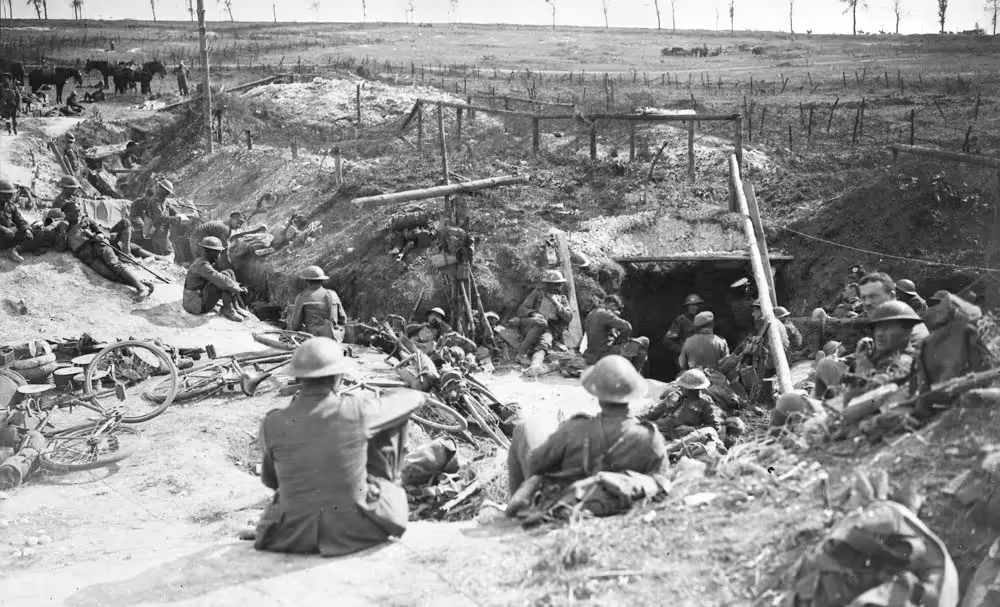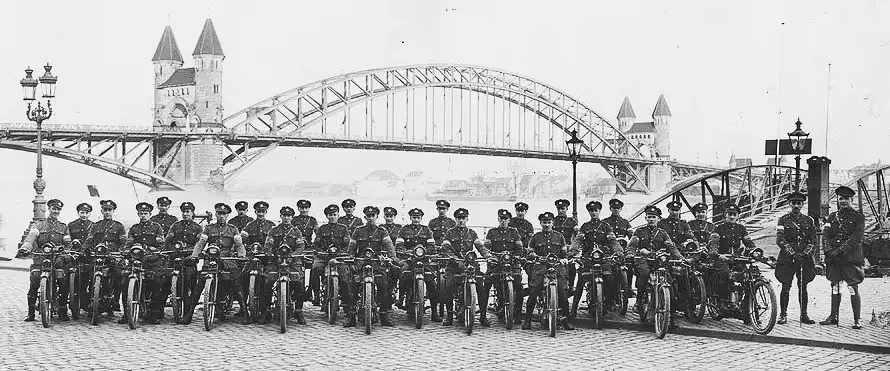Canadian Expeditionary Force (13) Canadian Corps of Signals
Canadian Corps of Signals

(York Sunbury Historical Society, Fredericton Region Museum Collection, Author Photo)
Accession No. 1997.28.595.
Corps Signal Company badge, Velox, Versutua, Vigilans (Swift, Skilled, Alert)
Canadian Corps of Signals, Canadian Engineers, Signal Service, in the Great War
The Canadian Corps of Signals signal service acted as a component of the Canadian Engineers during the Great War, providing signal companies for the four divisions, two artillery signal units, and a corps signal company for the Canadian Corps. A signal company also served with the Canadian contingent in Siberia in 1919. (CEFRG)
Signalling and Telephony
Visual signalling and telephony were the responsibility of the Canadian Corps of Signals. Telegraphy was a function of the Canadian Engineers. Therefore, The Signal Service of the Canadian Expeditionary Forces came under the command of the Canadian Engineers.
The telephone soon became the vital means of communication in France and Belgium and signal companies were increasingly occupied in the laying, maintaining and repair of air lines and cables.

(Library and Archives Canada Photo, MIKAN No. 3405811)
Canadian Signallers repairing wire in communication trench, February 1918.
Canadian Corps of Signals Organization
Divisional signal companies consisted of a headquarters section, a wireless section and two cable sections. The companies provided telephone and wireless service (including policing and interception) and visual signalling. Each company had motorcycle dispatch riders, a pigeon service and personnel for airline and cable construction, electric light and battery charging. They also operated repair shops for mechanical transport and for telephone, telegraph and wireless instruments.
Canadian Corps Signal Company
Organized at the Canadian Engineers Training Depot, Shorncliffe in September 1915 as Canadian Corps Headquarters Signal Company Royal Engineers. Commanded by Captain R. H. Willan. Composed of headquarters, No. 29 Airline Section and No. 31 Airline Section, R. Cable Section, and AD Cable Section, all Royal Engineers. Arrived in France on 15 September 1915. Canadian Cable and airline sections joined company after May 1916. Became Canadian Corps Signal Company, Canadian Engineers on 23 January 1917.
1st Canadian Divisional Signal Company, Canadian Engineers
Organized at Valcartier in August 1914 under the command of Major F. A. Lister. Personnel from the Permanent Force, from the 1st, 2nd, 3rd and 6th Signal companies of the NPAM and from Canadian Telegraph and Telephone companies. Left Quebec 28 September 1914 aboard MONMOUTH and ANDANIA. (“About 50 other ranks were detailed to the different boats of the convoy for the purpose of communication owing to the fact that the use of wireless was prohibited”). Arrived in England 18 October 1914. Strength: 14 officers, 252 other ranks. Arrived in France 11 February 1915. Strength: 6 officers, 204 other ranks, 1st Canadian Division. Demobilized at Toronto in May 1919.
.avif)
(Library and Archives Canada Photo, MIKAN No. 3405887)
2nd Battalion, CEF Signallers at the Scottish Lines near Poperinghe, near Ypres. The 2nd Battalion was in Rest Billets after fighting at Sanctuary Woods, Maple Copse.
2nd Canadian Divisional Signal Company, Canadian Engineers
Canadian Engineers Training Depot, Ottawa. Left Montreal 15 May 1915 aboard MEGANTIC. Arrived in England 24 May 1915. Strength: 9 officers, 313 other ranks, 2nd Canadian Division. Arrived in France 13-15 September 1915. Demobilized at Toronto in May 1919.
.avif)
(Library and Archives Canada Photo, MIKAN No. 3405816)
Canadian Signallers using German rifle as telephone pole. Advance East of Arras., September 1918.

(Library and Archives Canada Photo, MIKAN No. 3403791)
Signal Station “Gibraltar” Pozières, France, November 1916.
3rd Canadian Divisional Signal Company, Canadian Engineers
Organized in France in December 1915 under the command of Major T. E. Powers. Personnel from 2nd Canadian Mounted Rifles, Royal Canadian Regiment, Princess Patricia’s Canadian Light Infantry, 42nd and 49th Battalions. Demobilized at Ottawa in March 1919.

(Library and Archives Canada Photo, MIKAN No. 3521896)
Signallers repairing telephone wire damaged by flood, April 1917.
3rd Canadian Divisional Signal Company, Canadian Engineers
Organized in Ottawa under the command of Captain J. R. Beggs. Authorization published in General Order 69 of 15 July 1916. Left Halifax 17 March 1916 aboard LAPLAND. Arrived in England 25 March 1916. Strength: 5 officers, 198 other ranks. Disbanded on arrival at Canadian Engineer Training Depot, Shorncliffe.

(Library and Archives Canada Photo, MIKAN No. 3405815)
Canadian Signal Section moving forward to lay cable. Advance East of Arras, September 1918.

(Library and Archives Canada Photo, MIKAN No. 3381020)
Canadian Signal Section trying to get a connection, Battle of Passchendaele, November 1917.
4th Canadian Divisional Signal Company, Canadian Engineers
Organized in Ottawa in March 1916 under the command of Lieutenant F. H. M. Jones. Authorization published in General Order 69 of 15 July 1916. Left Halifax 22 May 1916 aboard BALTIC. Arrived in England 31 May 1916. Disbanded on arrival at Canadian Engineers Training Depot, Shorncliffe.
4th Canadian Divisional Signal Company, Canadian Engineers
Organized in Shorncliffe in May 1916 under the command of Major A. G. Lawson. Personnel from Canadian Engineers Training Depot, Shorncliffe. Arrived in France 12 August 1916. 4th Canadian Division. Demobilized at Toronto in June 1919.

(Library and Archives Canada Photo, MIKAN No. 3405820)
Officers and NCOs of the 4th Divisional Signal Company, La Hulpe, Belgium, 29 April 1919.
5th Canadian Divisional Signal Company, Canadian Engineers
Organized in Witley in January 1917 under the command of Captain W. M. Miller. Personnel from Signal Company, Canadian Engineers Training Depot, Crowborough. Detachment proceeded to France in August 1917 with the 13th and 14th Brigades, Canadian Field Artillery. Remainder of company disbanded at Witley in February 1918.
6th Canadian Divisional Signal Company, Canadian Engineers
Organized at the Engineers Training Depot, St-Jean in August 1918 under the command of Major W. McIntosh. Arrived at Vladivostock, 27 February 1919. Returned to Vancouver in June 1919.

Switchboard made by Canadian Corps Signals, May 1918.
(Library and Archives Canada Photo, MIKAN No. 3381014)
Cable Section
CA, CB and CD Cable Sections organized at the Canadian Engineers Training Depot in February 1916 as part of the programme to convert Canadian Corps signal from Royal Engineers. CD Section arrived in France 25 April 1916. CA and CB Sections arrived in France 26 May 1916. Strength of each section: 1 officer,35 other ranks. CE Section organized at Shorncliffe 20 August 1916. Arrived in France 10 October 1916.
Attached to Canadian Corps Signal Company 16 October 1916 CF Section organized at Crowborough in November 1916. Arrived in France in January 1917. Formed Canadian Corps Signal Company 10 January 1917. CA, CB and CD Sections disbanded and re-formed as CG and CH Cable Sections.
No. 57 Motor Airline Section
Organized at Shorncliffe in January 1916 as Canadian Overseas Motor Airline Section. Redesignated in sequence with the numbering of similar British units. Commanded by Lieutenant H. W. Dowson. Establishment: 1 officer, 40 other ranks. Personnel from Signal Reserves, Canadian Engineers Training Depot, Shorncliffe. Arrived in France 26 May 1916. Allotted to Canadian Corps Signal Company. Constructed and repaired telegraph lines. Redesignated No. 1 Canadian Motor Airline Section on 18 June 1918.

(Library and Archives Canada Photo, MIKAN No. 3522258)
No. 2 Canadian Motor Airline Section
Organized at Ottawa. Personnel from Canadian Engineers Training Depot, Ottawa. Arrived in England 1st June 1916.Absorbed by Canadian Engineers Training Depot, Shorncliffe.
1st Canadian Cavalry Brigade Signal Troop, Canadian Engineers
Organized at Canterbury in April 1915 under the command of Captain L.P. Haviland. Composed of Royal Engineers personnel. Establishment: one officer, 23 other ranks. Arrived in France 17 June 1915. Demobilized at Bramshott in April 1919.
Canadian Corps Wireless Section, Canadian Engineers
Organized in France in November 1916 under the command of Lieutenant J.C. Manson. Reorganized into corps and divisional detachments in July 1917. Absorbed into divisional signal companies.

Signallers, 7th Infantry Battalion, 6 August 1916.
(Library and Archives Canada Photo, MIKAN No. 3405955)

(RC Sigs Photo)
Canadian Corps Signals CH Cable Section Bonn 1919.

(RC Sigs Photo)
Despatch Rider Section., Bonn Germany in 1919.

